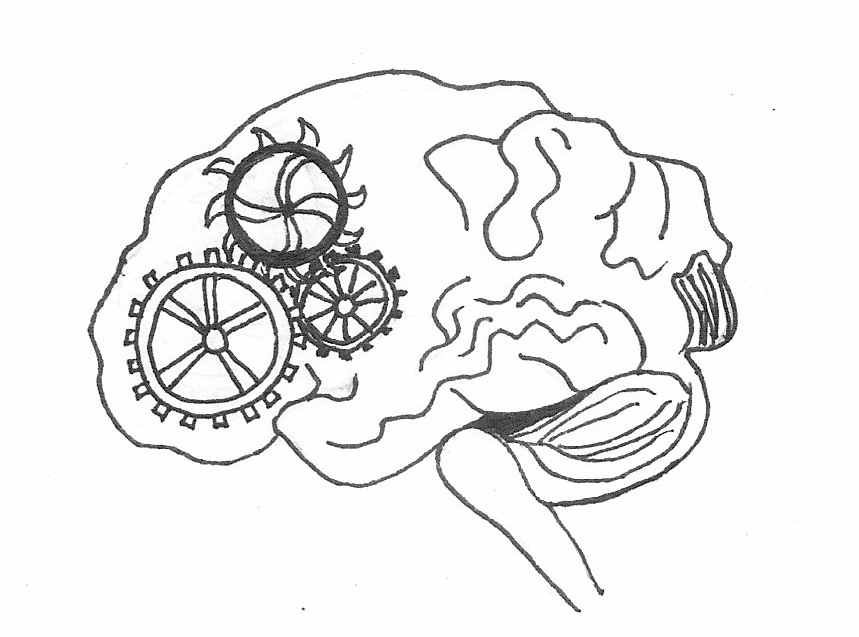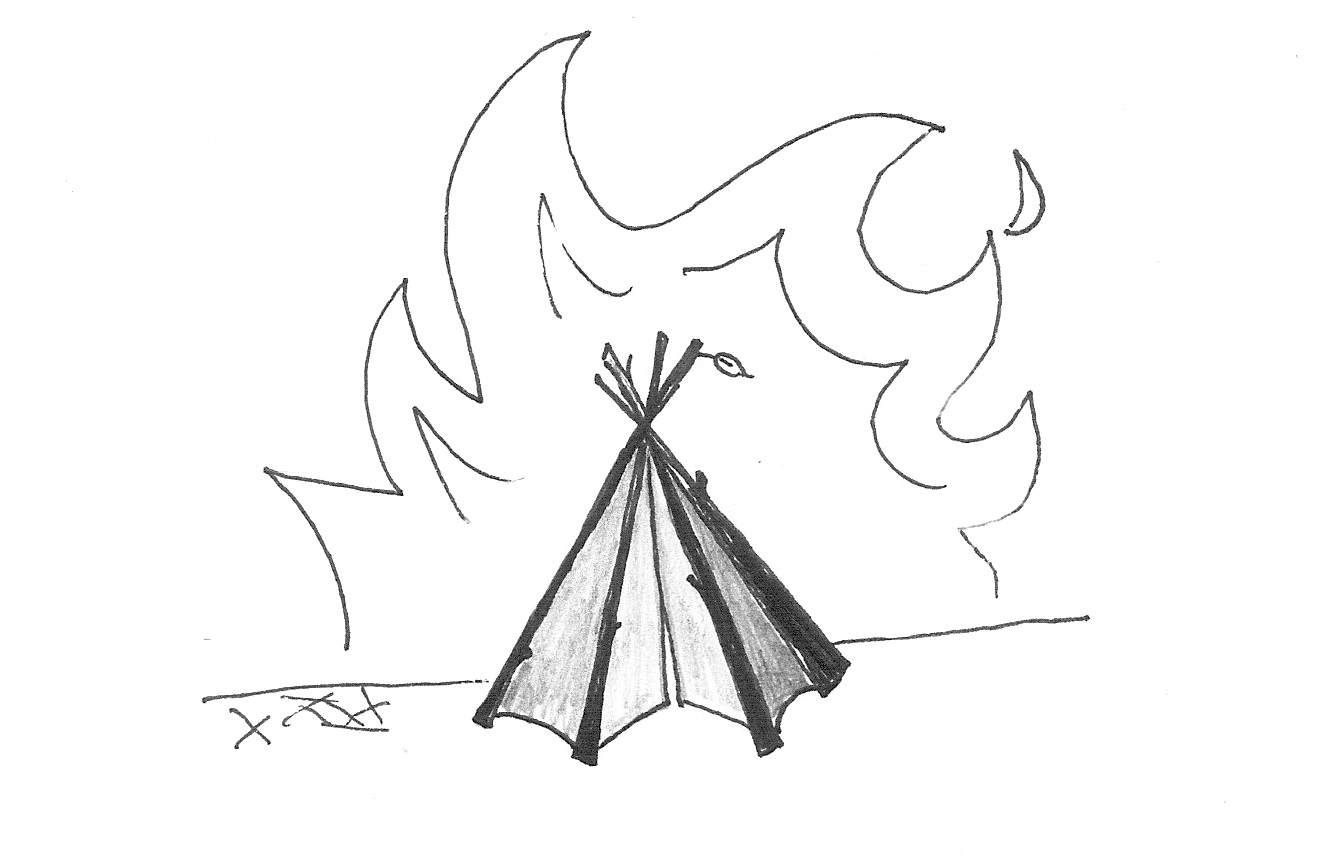
SYMPATHY FOR THE CANVAS
Have you heard about mirror neurons?
In the 1980s and ’90s, neuroscientists studying macaque monkey brains began noticing that some of the same neurons responded when the monkeys put food in their mouths or when they watched other monkeys or humans put food in their own mouths. The same thing happened for other actions: ripping a piece of paper, for example. Basically, what this means is that when the monkeys watched others performing actions, they felt, on some level, as if they were performing those actions themselves. Scientists named the responsive neurons “mirror neurons.”
In monkeys, we can observe the behavior of single neurons. With humans, the observation is somewhat more speculative: scientists have used functional magnetic resonance imaging (fMRI) to see that the same areas of the brain activate whether a person performs an action or watches someone else do it. They call this “mirroring mechanism” and “embodied response.” People are excited about this field of discovery for a few reasons: it could strike a blow against the mind-body split, showing just how connected our minds and bodies really are; it might also undermine concepts of individual autonomy, suggesting that our brains process other people’s experience almost as if it’s our own; it might explain how some kinds of learning and communication happen; it might help us understand empathy.
Italian neuroscientist Vittorio Gallese and American art historian David Freedberg are interested in what mirror neurons might explain about how people experience art. Writing for Trends in Cognitive Sciences in 2007, they collate a variety of scientific studies, aesthetic philosophy, and anecdotal evidence to argue that viewers of visual art empathize as much or more with the creator than with the representation. With representations of figures (this probably includes anything that could be processed by the brain to be at all human- or animal-shaped), viewers feel an embodied response: an activation in the part of their brains associated with the body part(s) involved in the position or action of the figure in the painting.
Gallese and Freedberg argue that viewers experience similar embodied response to abstract art as well. Studies suggest that embodied response even occurs when people look at handwriting: they show a mirror response in the “hand area” of the brain, unconsciously identifying with the writer. When looking at a Jackson Pollock painting
viewers often experience a sense of bodily involvement with the movements that are implied by the physical traces—in brushmarks or paint drippings—of the creative actions of the producer of the work. This also applies to the cut canvases of Lucio Fontana, where sight of the slashed painting invites a sense of empathetic movement that seems to coincide with the gesture felt to have produced the tear.
When I look at Fontana’s work online, I do not consciously notice myself mirroring the experience of stabbing. Rather, I consciously want to touch the cut. My fingertips imagine the texture of the canvas, the way you can still feel the weave through the paint, how the edges of the slashes would be stiff with paint, almost sharp to the touch. I wonder if some viewers identify with the canvas itself, and experience the violent sensation of being slashed.
Can this apply to text as well as visual images? Do people experience embodied responses to printed language, that is, to its content, to what is represented rather than the marks of the ink on the page?
SYMPATHY FOR PAPER?
A few years ago, I was curious about what happened to these neuroscientific hypotheses when you applied them to metafiction. So I wrote an essay about David Foster Wallace’s short story, “Westward the Course of Empire Takes Its Way.” “Westward” admits to be “written in the margins” of two stories: John Barth’s “Lost in the Funhouse” and another short story I didn’t read until much later, “Usurpation (Other People’s Stories)” by Cynthia Ozick. I did not include Ozick in the original paper because (a) I didn’t have enough time to do the research, and (b) I had no fucking idea what to say about her. I want to say some things about her now.
This essay is made of parts of that one, and thinking I’ve done since. My writing was better then, but my thinking is better now. See if you can tell which is which. My dog keeps interrupting my typing, because she wants me to let her go outside and eat her own shit. I will not let her do this, because she may have new, mysterious, undetectable worms that may reenter her gut if she eats her own shit. This is a real and true medical problem, but it might also be a metaphor for my writing process.
However. Regarding “Westward.” People do not like this story. Most call it a novella, which probably makes them hate it even more. Wallace himself did not like this story.1 I don’t know if I like this story. But I am interested, I am invested in its project of investigating the whys of fiction writing and fiction reading and understanding the place of narrative in human life. Throughout the story, Mark Nechtr, a blocked writer, tries to imagine exactly what kind of story to write—what kinds of stories should be written. While he loves “Lost in the Funhouse,” Mark considers it a story that “does not love. . . . The story does not love, but this is precisely because it is not cruel.” Is “Westward the Course of Empire Takes Its Way” a story that does love? It says it does. Here is its final passage:
Jesus, Sweets, listen. Hear it? It’s a love song.
For whom?
You are loved.
All of which is to say, Wallace is a writer who is loved. “Westward” is a story that claims to love its reader. Yet “Westward” itself is unloved. What gives?
“Usurpation (Other People’s Stories),” on the other hand, doesn’t claim to love anyone, although many readers might call it cruel. The story doesn’t even seem to like anyone, especially not the reader. Reviews of this story range from bemused to annoyed to dismissive. (Although it is perhaps more significant to note that it was reviewed, in all the places important books are reviewed.) Some people liked “Usurpation” enough to give it an O. Henry Award in 1975. In my world, in 2015, Cynthia Ozick is a writer few people have heard of and nobody has read. So why not leave this book collecting dust on a forgotten library shelf? (Why) do her theories and anxieties about fiction matter?
A: David Foster Wallace says so. Or some version of him did at some point in his life.
A: Laura Knowles Wallace says so, right now.
A: They don’t. But let’s pretend.
QUESTIONS OF GENRE ARE BORING QUESTIONS
When fiction directly acknowledges its status as linguistic performance or construction, it is often called metafiction. Many critics and writers charge metafiction with being overly cerebral and thus not as easy to get lost in as realist fiction. While realist fiction works through readers’ mechanisms like trying to understand the plot, identifying with characters and evaluating their actions, metafiction is often accused of being more like philosophy, asking readers to think about abstract concepts rather than the story at hand. Cognitive literary critics have their qualms about dividing types of fiction along an axis that places feeling on one end and thought on the other (a Kinsey scale for narrative?). H. Porter Abbott contends that “reader-resistant” texts “are “forms of perverse indulgence—in effect, evolutionary misbehavior.” There is power and pleasure in such misbehavior, for the reader who’s willing to put in the work. These texts are experiential rather than representational. In foregrounding their own linguistic performance, so-called reader-resistant texts force readers to foreground their own cognitive performances and processes—which does not preclude embodied response, and may be itself an embodied experience.
As for his own story, Wallace refuses to classify it, stating, perhaps jokingly, “if this were a piece of metafiction, which it’s NOT” and later pushing even further, repeatedly starting paragraphs with “If this were fiction.” This story and its parent stories acknowledge repeatedly that there is something wrong, something improper, unnatural about themselves. Although they should proceed like proper, conventional narratives, they cannot. The narrators express unease, directly addressing readers. As a display of goodwill, they worry about our comfort and enjoyment. “I beg you to wait,” says Ozick’s narrator, “Trust me a little. I will get through it as painlessly as possible.” Later she regretfully confesses, “I have broken my promise; already I have begun to bore you. Boring!” Wallace’s narrator plainly states, “I am acutely aware that our time together is valuable. Honest. So, conscious of our need to get economically to business, here are some plain, true, unengaging propositions I’ll ask you just to acknowledge.” Some readers experience lines like these as showing genuine anxiety, shared by writer and narrator. Others see this move as typical postmodern trickery, trying to get us on their side so they can more easily mess with our heads.
FOR WHOM?
Reviewing 1975’s anthology of O. Henry Award-winning stories for The New York Times, Anatole Broyard wrote that
Miss Ozick’s story [“Usurpation”] is highly intelligent, erudite, technically accomplished—and frustrating. William Abrahams, editor of this anthology, calls it tantalizing—and indeed it is. But I must admit I don’t enjoy being tantalized. I want a story to give me something, not to tease me with possibilities. Technique as mystification, as a device for creating suspense, seems to me to be a sterile intellectual game.
This is a common critique leveled at metafiction: in being intellectual, cerebral, engaging with questions about what fiction is and does, it fails to do what fiction is supposed to do. What fiction is supposed to do is immerse readers in the world of its making, provide them with emotional experiences and/or distracting entertainment.
Many critics would argue the difference between fiction and theory is embodied response, that reading fiction is a visceral, emotional experience while reading theory and/or criticism is a “purely” cerebral one. I want to suggest, however, that theory and/or criticism—especially though not exclusively when mixed with fictional narratives—carry their own affective charge. In “Usurpation,” “Westward” and “Lost in the Funhouse,” Ozick, Wallace, and Barth, respectively, integrate realistic third-person narration about the stories’ events and characters with commentary on story writing. Rather than seeing their narrators’ metafictional incursions as interruptions, can we read them as part of these stories’ emotional content? Rather than ingesting these texts as theoretical medicine sweetened with stories, can we savor them as complex but singular confections? What, then, are the feelings of the kinds of thinking these writers ask us to perform?
Confusion, first of all. Confusion about how to read. Like most metafiction, they require work on the part of their readers. Work to code-switch between story and discourse. Work to sort out narrative threads, layers of allusions, to get the joke. To allow these stories to reconstruct themselves in our minds, as all narrative does. And it feels like work, exertion in my brain, a tingling physical sensation centralized in the upper front part of my skull. Wallace argues in nearly every interview I’ve read that this is particularly important at the turn of the millennium, with the plethora of passive media, like television, available whenever we want it, Americans need challenging books more than ever to exercise our minds. In this formulation, confusion is a way station en route to understanding, and the ideal reader is one who hacks their way through it with a machete. That ideal reader has decided, probably before even opening the book, that it will be worth the time and attention she spends on it. Real readers may make different calculations, may save their time and attention for some other activity.
The noble intention to help readers exercise their minds does not protect these texts from charges of tedium. As I indicated above, Wallace and Ozick make plain their anxiety about boring their readers. At one point in “Lost in the Funhouse,” John Barth writes:
At this rate our hero, at this rate our protagonist will remain in the funhouse forever. Narrative ordinarily consists of alternating dramatization and summarization. One symptom of nervous tension, paradoxically, is repeated and violent yawning.
But, he suggests, Ambrose does yawn. You might, too, for reasons of nervous tension—anxiety passed from narrator to reader like a virus, or some anxiety of your own (maybe about how you hate this kind of story, but feel obligated to read it by internal or external compulsion), or nervous tension’s opposite, drowsiness. You might very well close the book, put it down and never pick it up again, as you might feel the urge to do now with this essay. This would be a perfectly valid action based on a perfectly valid embodied response—or lack thereof. The reader who closes the book in frustration, who asks whether there is a point to all this, is perhaps the wisest reader of these stories that ask whether there is a point to writing stories, whether writing (and reading) stories connects people or alienates them from each other. All the self-criticism and self-mockery can activate a reader’s sympathies, irritate her as a clichéd ploy, or invoke similar literary/existential anxiety—even all three at once.
I want to argue that these stories induce claustrophobia or vertigo, but I cannot say I experienced this while reading them. However, one feeling I did experience at moments in “Westward,” in between or on top of all this tedium and confusion, was a sense of revelation, particularly at the end, the sense that I was in the presence of—and here I get a little cheesy—truth. The kind that makes you feel uplifted just because it makes sense, in your bones, but still comes as a surprise. I am somewhat loath to admit this in general, and especially to admit it in relation to a text that so self-consciously presents itself as Important Fiction, Fiction of Ideas. But there you are. I must emphasize that, for me anyway, this kind of revelation is a feeling, an embodied response, abstract though it may seem. It is a certain sensation of opening up in my chest, the feeling that time has stopped, a certain sense of elation. I suspect this is how more spiritual people feel sometimes when they pray, meditate, or worship. The thing about this feeling is, it might just be me. That’s always the catch with embodied response: even though it’s activated by something outside your brain, it’s still mediated by that brain.
I had another, even more peculiar embodied response when I reread “Westward” for a second time. I cried. I had not previously empathized with the unlovable D. L. She is a pretentious, self-absorbed self-described postmodernist who refuses to “be seen” in any car that is not a Datsun. But there are hidden moments when the reasons for her unpleasantness come to light. Particularly, the narrator tells us about what happened after Mark fell asleep the night they first “hooked up.” She tells her sleeping lover a story she has never told anyone, about her father’s nervous breakdown:
She was forced to do the whole rehearsed dialogue mono-, playing both parts, Ophelia-like: the only time in her life she’s laughed so hard she had to bite her arm to stop:
“My Daddy’s long gone. He’s whacked. Looned. Zoned. Where all rooms are white and all shoes are noiseless. My father has left the planet.
“Well as long as he waves, occasionally.”
“I think the only thing he waves at is his food.”
“Well, as long as it doesn’t wave back. . .”
“I think that’s why he waves in the first place.”
Given this back-story about the only person who has ever “told [D. L.] she was loved,” when I came to the line “Drew-Lynn Eberhardt can tell DeHaven Steelritter and J. D. love each other, deep down, and this affects her. She is enormously sensitive to who is loved by whom,” I more than teared up. Although I empathize with the pathos of the situation, I suspect also that (a) I reread the story in a crying mood due to unrelated circumstances, and (b) I responded to D. L. this way because of our shared gender.
Wallace primes readers to notice gender by taking the character of Magda from “Lost in the Funhouse.” In that story, she is a callous “well-developed” girl who is the object—not the subject—of Ambrose’s desire. Wallace imagines Magda’s subjectivity, born of her construction as an object in Barth’s story:
Maybe because she’s never, never once, been made to be anything other than what others see, Magda Ambrose-Gatz has vast untapped resources of virtue and smarts and all-around balls. . . never called on to see others, or to speak, she can actually listen. And sees, inside. Never called on to speak, she can actually love her own tongue, as those born to subjection may love their skin, ears, eyes.
Thinking about the danger of solipsism leads Wallace to humanize, to round out those characters who have been flattened by his predecessor. But then he reveals Magda to maybe-probably be Dr. Ambrose (Barth) himself in drag. That is, he embodies this character from Barth’s story, then recognizes her as still a fictional character, constructed by Barth: another one of his postmodern moves, “this self-conscious and deconstructed disclosure supposedly making said metafiction ‘realer’ than a piece of pre-postmodern ‘Realism.’” Realness here means recognizing every character as really an avatar of the author. Which may be another reason why I cried, empathizing with the unloved D. L., with the Wallace who feels unloved. The moment of losing-oneself-in-the-fiction happens in spite of the meta scaffolding, even as it is revised by that scaffolding. So metafiction needs moments of reader-character empathy to be effective or at least affecting?
EMPATHY FOR WHOM?
Ozick’s narrator, while equally worried about maintaining reader interest, is nevertheless much less likeable than Wallace’s. Much of this may be that she’s2 conflicted, like Ozick herself in essays and interviews, consumed simultaneously by a desire to read and write stories and a belief that creative art is equal to idolatry. This narrator is possessive of her stories, jealous of her talent, judgmental of others. The most conventionally affecting moment of “Usurpation” comes, for me, with its final line, when the narrator has a vision of Paradise. She sees the Jewish poet Tchernichovsky “eat[ing] nude at the table of nude gods” while the Israeli Nobel winner S. Y. Agnon “murmur[s] psalms. . . and polishes his Prize.” Tchernichovsky, who idealized Classical Greece and Rome, avoids worship services on the Sabbath. “Then the taciturn little Canaanite idols call him, in the language of the spheres, kike.” This single word underscores the outsiderness that Ozick suggests a serious Jewish writer is bound to face, even when he seems to have embraced secular bohemianism. It also represents the incursion of real histories of violence and division in a story filled with ghosts and magic crowns. One ugly four-letter slur punctuates Ozick’s ethereal vision.
EMPATHY FOR WHOM ?
I do not mean to suggest that the narrator in either case lines up neatly with the author. I regard the text as a performance, and the narrator is as much a textual representation as any other character or aspect of the story. The author contained in the text is its implied author, an idea that comes to me from the literary critic Wayne Booth. The implied author, represented as a consciousness that controls and often dominates the discourse of a text, functions as a singular and possibly verifiable subject.
Implied authors—let’s not even go that far. Narrators themselves are the protagonists of these tales. These authors pull back the curtain to reveal the consciousness structuring the story. They reveal or perform their writing process, putting the reader in writer’s shoes rather than the shoes of a more obviously fictional character. In opening their implied authorial selves up to readerly empathy, they use their supposed anxiety around narrative authority to shift that authority to the reader, asking—even begging—us to disagree with the choices they have revealed to us as choices (though, of course, all narratives are really in some sense sequences of authorial choices). Barth, Ozick, and Wallace invite us into the back room with the levers and buttons that control the funhouse. But, you might say, this is still an illusion. The words are already written, printed there on the page, purchased by the reader. The author is still in control.
Of course, the authorial subjectivity being performed in fiction is just that. Although readers may recognize that an author exists in the world as an embodied human, when we read, it is our own subjectivity we recognize. I wonder if texts can offer love because a text does not inhere in a body or demand recognition of a real subjectivity on the other side. We can accept their love and bask in its warmth, or we can reject it, no harm done.
When we read, we consciously enter what Gallese calls a “we-centric space.” Gallese uses this phrase to describe a space humans actually always inhabit, which he also calls the “shared manifold.” The mirror neuron system, working constantly on our embodied minds, means that human experience is intercorporeal. We come to an understanding of “reality” through this intercorporeality, but it paradoxically also demands that we recognize the boundaries between our selves and others. There could be no intercorporeality if the bodies in question simply melt into each other.
Wallace simultaneously reminds us of the bookness of the book AND wants us to love him, or at least to think he and/or the story loves us. He wants to pretend or imagine a relationship between reader and writer or text and writer or he performs as if he does, tries to construct this scaffold, this house in the reader’s mind. The house that gets built isn’t necessarily the one he designed. Reading’s a ritual of making and unmaking (as the great Jean-Michel Basquiat once wrote on a wall, “PAY FOR SOUP / BUILD A FORT / SET THAT ON FIRE”).
Ozick suggests that love isn’t the right word, exactly, for this kind of connection. This kind of interdependence: “To say that I have been thoroughly assimilated into English would of course be the grossest understatement—what is the English language (and its poetry) if not my passion, my blood, my life? But that perhaps is overstatement. A language, while we are zealously acquiring it, can be a passion and a life. A language owned in the root of the tongue is loved without being the object of love: there is no sense of separateness from it. Do I love my eyeballs? No; but sight is everything.” I’ve accepted that my dog sees me as a food dispenser. But I also believe that is love, true as it gets. Likewise, I’ve accepted that books are objects made of paper; the creations of imperfect individuals. But a book is also a way to communicate with a stranger; to feel like you’re sharing a brain with a stranger for a while.
Drawings by Marian Oman






